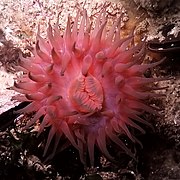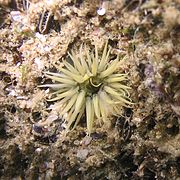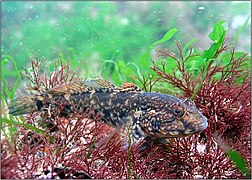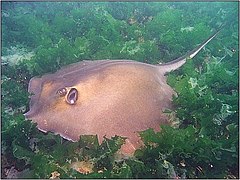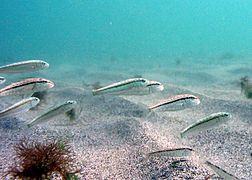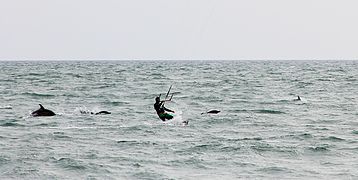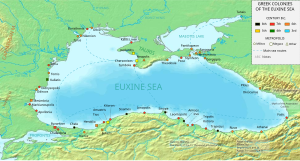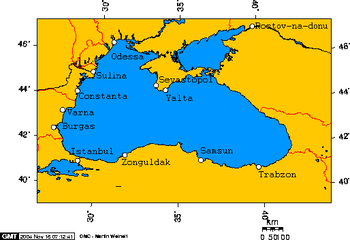Black Sea
Jump to navigationJump to search
| Black Sea | |
|---|---|

The location of the Black Sea
|
|
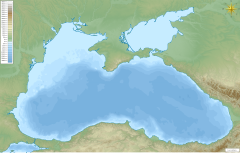
Map of the Black Sea with bathymetry and surrounding relief
|
|
| Location | Europe |
| Coordinates | 44°N 35°ECoordinates: 44°N 35°E |
| Type | Sea |
| Primary inflows | Danube, Dnieper, Southern Bug, Dniester, Don, Kuban, Rioni, Kızılırmak |
| Primary outflows | Bosporus |
| Basin countries | Bulgaria, Romania, Ukraine, Russia, Georgia, Turkey A large number of countries included in drainage basins for inflow rivers |
| Max. length | 1,175 km (730 mi) |
| Surface area | 436,402 km2 (168,500 sq mi) / 422,000 km2 (Exclude Sea of Azov) and 441,000 km2 (Include shallow Sea of Azov)[1] |
| Average depth | 1,253 m (4,111 ft) |
| Max. depth | 2,212 m (7,257 ft) |
| Water volume | 547,000 km3 (131,200 cu mi) |
| Islands | 10+ |

Sanatorium Ordzhonikidze in Sochi, Russia
The Black Sea is a body of water and marginal sea of the Atlantic Ocean between Eastern Europe, the Caucasus, and Western Asia.[2] It is supplied by a number of major rivers, including the Danube, Dnieper, Southern Bug, Dniester, Don, and the Rioni. The watersheds of many countries drain into the Black Sea beyond the six that immediately border it.[3]
The Black Sea has an area of 436,400 km2 (168,500 sq mi) (not including the Sea of Azov),[4] a maximum depth of 2,212 m (7,257 ft),[5] and a volume of 547,000 km3 (131,000 cu mi).[6] It is constrained by the Pontic Mountains to the south, Caucasus Mountains to the east, Crimean Mountains to the north, Strandzha to the southwest, Balkan Mountains to the west, and the Dobrogea Plateau to the northwest, and features a wide shelf to the northwest.
The longest east–west extent is about 1,175 km (730 mi).[7] Important cities along the coast include Odessa, Sevastopol, Samsun, and Istanbul.
The Black Sea is bordered by Ukraine, Romania, Bulgaria, Turkey, Georgia, and Russia. It has a positive water balance with an annual net outflow of 300 km3 (72 cu mi) per year through the Bosporus and the Dardanelles into the Aegean Sea.[citation needed] While the net flow of water through the Bosporus and Dardanelles (known collectively as the Turkish Straits) is out of the Black Sea, generally water is flowing in both directions simultaneously. Denser, more saline water from the Aegean flows into the Black Sea underneath the less dense, fresher outflowing water from the Black Sea. This creates a significant and permanent layer of deep water which does not drain or mix and is therefore anoxic. This anoxic layer is responsible for the preservation of ancient shipwrecks which have been found in the Black Sea.
The Black Sea ultimately drains into the Mediterranean Sea, via the Turkish Straits and the Aegean Sea. The Bosporus Strait connects it to the small Sea of Marmara which in turn is connected to the Aegean Sea via the Strait of the Dardanelles. To the north the Black Sea is connected to the Sea of Azov by the Kerch Strait.
The water level has varied significantly over geological time. Due to these variations in the water level in the basin, the surrounding shelf and associated aprons have sometimes been dry land. At certain critical water levels, connections with surrounding water bodies can become established. It is through the most active of these connective routes, the Turkish Straits, that the Black Sea joins the world ocean. During geological periods when this hydrological link was not present, the Black Sea was an endorheic basin, operating independently of the global ocean system (similar to the Caspian Sea today). Currently, the Black Sea water level is relatively high; thus, water is being exchanged with the Mediterranean. The Turkish Straits connect the Black Sea with the Aegean Sea and comprise the Bosporus, the Sea of Marmara, and the Dardanelles. The Black Sea undersea river is a current of particularly saline water flowing through the Bosporus Strait and along the seabed of the Black Sea, the first of its kind discovered.
Extent[edit]
The International Hydrographic Organization defines the limits of the Black Sea as follows:[8]
On the Southwest. The Northeastern limit of the Sea of Marmara [A line joining Cape Rumili with Cape Anatoli (41°13’N)]. In the Kertch Strait. A line joining Cape Takil and Cape Panaghia (45°02’N).
Exclusive economic zone[edit]
Exclusive economic zones in Black Sea (Include Sea of Azov):[9]
| Number | Country | Area (Km2) |
|---|---|---|
| 1 | 172,484 | |
| 2 | 132,414 | |
| 3 | 67,351 | |
| 4 | 35,132 | |
| 5 | 29,756 | |
| 6 | 22,947 | |
| Total | Black Sea | 460,084 |
Coastline length by country[edit]
Coastline length in Black Sea (Include Sea of Azov):[10]
| Number | Country | Length (Km) |
|---|---|---|
| 2 | 2,782 | |
| 1 | 1,329 | |
| 3 | 800 | |
| 4 | 354 | |
| 5 | 310 | |
| 6 | 225 | |
| Total | Black Sea | 5,800 |
Basin countries[edit]
Black Sea Basin countries, 2 million square kilometre basin and 25 countries:[11][12][13][14][15]
Note: In some sources, Armenia is also considered.
Largest bays[edit]
Largest bays on the Black Sea:[16]
- Karkinit Bay,
 Russia
Russia - Burgas Bay,
 Bulgaria
Bulgaria - Dnieprovski Bay,
 Ukraine
Ukraine - Dniestrovski Bay,
 Ukraine
Ukraine - Sinop Bay,
 Turkey
Turkey - Samsun Bay,
 Turkey
Turkey
Largest rivers[edit]
Largest rivers flowing into the Black Sea:[17]
Population[edit]
 Istanbul  Odessa |
Rank | City | Country | Region/County | Population (urban) |
 Samsun  Constanța |
|---|---|---|---|---|---|---|
| 1 | Istanbul | Turkey | Istanbul | 14,324,240[18] | ||
| 2 | Odessa | Ukraine | Odessa | 1,003,705 | ||
| 3 | Samsun | Turkey | Samsun | 535,401[19] | ||
| 4 | Constanța | Romania | Constanța | 491,498[20] | ||
| 5 | Varna | Bulgaria | Varna | 474,076 | ||
| 6 | Sevastopol | disputed: Russia (de facto) / Ukraine (de jure) | Federal city / City with special status | 379,200 | ||
| 7 | Sochi | Russia | Krasnodar Krai | 343,334 | ||
| 8 | Trabzon | Turkey | Trabzon | 305,231[21] | ||
| 9 | Novorossiysk | Russia | Krasnodar Krai | 241,952 | ||
| 10 | Burgas | Bulgaria | Burgas | 223,902[22] | ||
| 11 | Ordu | Turkey | Ordu | 217,640 | ||
| 12 | Batumi | Georgia | Adjara | 204,156[23] |
Geology and bathymetry[edit]
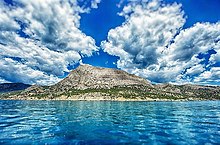
The bay of Sudak, Crimea

Yavuz Sultan Selim Bridge is on the Black Sea connecting Europe to Asia. One of the longest suspension bridges in the world.
The Black Sea is divided into two depositional basins—the Western Black Sea and Eastern Black Sea—separated by the Mid-Black Sea High, which includes the Andrusov Ridge, Tetyaev High, and Archangelsky High, extending south from the Crimean Peninsula. The basin includes two distinct relict back-arc basins which were initiated by the splitting of an Albian volcanic arc and the subduction of both the Paleo– and Neo-Tethys Oceans, but the timings of these events remain uncertain. Arc volcanism and extension occurred as the Neo-Tethys Ocean subducted under the southern margin of Laurasia during the Mesozoic. Uplift and compressional deformation took place as the Neotethys continued to close. Seismic surveys indicate that rifting began in the Western Black Sea in the Barremian and Aptian followed by the formation of oceanic crust 20 million years later in the Santonian.[24][25][26] Since its initiation, compressional tectonic environments led to subsidence in the basin, interspersed with extensional phases resulting in large-scale volcanism and numerous orogenies, causing the uplift of the Greater Caucasus, Pontides, Southern Crimean Peninsula and Balkanides mountain ranges.[27]
During the Messinian salinity crisis in the neighboring Mediterranean Sea, water levels fell but without drying up the sea. [28]
The ongoing collision between the Eurasian and African plates and westward escape of the Anatolian block along the North Anatolian Fault and East Anatolian Faults dictates the current tectonic regime,[27] which features enhanced subsidence in the Black Sea basin and significant volcanic activity in the Anatolian region.[29] These geological mechanisms, in the long term, have caused the periodic isolations of the Black Sea from the rest of the global ocean system.
The large shelf to the north of the basin is up to 190 km (120 mi) wide and features a shallow apron with gradients between 1:40 and 1:1000. The southern edge around Turkey and the eastern edge around Georgia, however, are typified by a narrow shelf that rarely exceeds 20 km (12 mi) in width and a steep apron that is typically 1:40 gradient with numerous submarine canyons and channel extensions. The Euxine abyssal plain in the centre of the Black Sea reaches a maximum depth of 2,212 metres (7,257.22 feet) just south of Yalta on the Crimean Peninsula.[30]
The littoral zone of the Black Sea is often referred to as the Pontic littoral or Pontic zone.[31]
The area surrounding the Black Sea is commonly referred to as the Black Sea Region. Its northern part lies within the Chernozem belt (black soil belt) which goes from eastern Croatia (Slavonia), along the Danube (northern Serbia, northern Bulgaria (Danubian Plain) and southern Romania (Wallachian Plain)) to northeast Ukraine and further across the Central Black Earth Region and southern Russia into Siberia.[32]
Chronostratigraphy[edit]
The Paleo-Euxinian is described by the accumulation of eolian silt deposits (related to the Riss glaciation) and the lowering of sea levels (MIS 6, 8 and 10). The Karangat marine transgression occurred during the Eemian Interglacial (MIS 5e). This may have been the highest sea levels reached in the late Pleistocene. Based on this some scholars have suggested that the Crimean Peninsula was isolated from the mainland by a shallow strait during the Eemian Interglacial.[33]
The Neoeuxinian transgression began with an inflow of waters from the Caspian Sea. Neoeuxinian deposits are found in the Black Sea below -20 m water depth in three layers. The upper layers correspond with the peak of the Khvalinian transgression, on the shelf shallow-water sands and coquina mixed with silty sands and brackish-water fauna, and inside the Black Sea Depression hydrotroilite silts. The middle layers on the shelf are sands with brackish-water mollusc shells. Of continental origin, the lower level on the shelf is mostly alluvial sands with pebbles, mixed with less common lacustrine silts and freshwater mollusc shells. Inside the Black Sea Depression they are terrigenous non-carbonate silts, and at the foot of the continental slope turbidite sediments.[34]
Oil and natural gas[edit]
The Black Sea contains oil and natural gas resources but exploration in the sea is incomplete. As of 2017, 20 wells are in place. Throughout much of its existence, the Black Sea has had significant oil and gas-forming potential because of significant inflows of sediment and nutrient-rich waters. However, this varies geographically. For example, prospects are poorer off the coast of Bulgaria because of the large influx of sediment from the Danube which obscured sunlight and diluted organic-rich sediments. Many of the discoveries to date have taken place offshore of Romania in the Western Black Sea and only a few discoveries have been made in the Eastern Black Sea.
During the Eocene, the Paratethys Ocean was partially isolated and sea levels fell. During this time sand shed off the rising Balkanide, Pontide and Caucasus mountains trapped organic material in the Maykop Suite of rocks through the Oligocene and early Miocene. Natural gas appears in rocks deposited in the Miocene and Pliocene by the paleo-Dnieper and pale-Dniester rivers, or in deep-water Oligocene-age rocks. Serious exploration began in 1999 with two deep-water wells, Limanköy-1 and Limanköy-2, drilled in Turkish waters. Next, the HPX (Hopa)-1 deepwater well targeted late Miocene sandstone units in Achara-Trialet fold belt (also known as the Gurian fold belt) along the Georgia-Turkey maritime border. Although geologists inferred that these rocks might have hydrocarbons that migrated from the Maykop Suite, the well was unsuccessful. No more drilling happened for five years after the HPX-1 well. Then in 2010, Sinop-1 targeted carbonate reservoirs potentially charged from the nearby Maykop Suite on the Andrusov Ridge, but the well-struck only Cretaceous volcanic rocks. Yassihöyük-1 encountered similar problems. Other Turkish wells, Sürmene-1 and Sile-1 drilled in the Eastern Black Sea in 2011 and 2015 respectively tested four-way closures above Cretaceous volcanoes, with no results in either case. A different Turkish well, Kastamonu-1 drilled in 2011 did successfully find thermogenic gas in Pliocene and Miocene shale-cored anticlines in the Western Black Sea. A year later in 2012, Romania drilled Domino-1 which struck gas prompting the drilling of other wells in the Neptun Deep. In 2016, the Bulgarian well Polshkov-1 targeted Maykop Suite sandstones in the Polshkov High and Russia is in the process of drilling Jurassic carbonates on the Shatsky Ridge as of 2018. [35]
In August 2020, Turkey has found 320 billion cubic meters of natural gas in the biggest ever discovery in the Black Sea, and hopes to begin production by 2023. The Turkish drilling ship Fatih, had been carrying out exploration operations in the Tuna-1 sector in the western Black Sea for the past month. The sector is near where Romania has also found gas reserves.[36]
Name[edit]
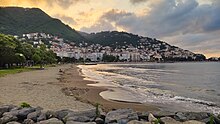
Coast of the Black Sea at Ordu
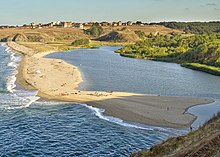
The estuary of the Veleka in the Black Sea. Longshore drift has deposited sediment along the shoreline which has led to the formation of a spit, Sinemorets, Bulgaria

The Black Sea near Constanța, Romania
Modern names[edit]
Current names of the sea are usually equivalents of the English name “Black Sea”, including these given in the countries bordering the sea:[37]
- Abkhazian: Амшын Еиқәа, IPA: [ɑmʂɨn ɛjkʷʰɑ]
- Adyghe: Хы шӏуцӏэ, IPA: [xə ʃʼəw.t͡sʼa]
- Bulgarian: Черно море, IPA: [ˈt͡ʃɛrno moˈrɛ]
- Crimean Tatar: Къара денъиз, Qara deñiz IPA: [qɑrɑ deŋiz]
- Georgian: შავი ზღვა, romanized: shavi zghva, IPA: [ʃɑvi zɣvɑ]
- Laz and Mingrelian: უჩა ზუღა, IPA: [utʃɑ zuɣɑ], or simply ზუღა, IPA: [zuɣɑ], “Sea”
- Romanian: Marea Neagră, pronounced [ˈmare̯a ˈne̯aɡrə] (
 listen)
listen) - Russian: Чёрное мо́рe, IPA: [ˈtɕornəjə ˈmorʲə]
- Turkish: Karadeniz, IPA: [kaˈɾadeniz]
- Ukrainian: Чорне море, IPA: [ˈtʃɔrnɛ ˈmɔrɛ]
Such names have not yet been shown conclusively to predate the 13th century.[38]
In Greece, the historical name “Euxine Sea” holds a different meaning (see below), is still widely used:
- Greek: Eύξεινος Πόντος, romanized: Éfxinos Póndos, [ˈefksinos ˈpondos], lit. “Hospitable Sea”; the name Μαύρη Θάλασσα (Mávri Thálassa), [ˈmavri ˈθalasa], lit. “Black Sea” is used, but is much less common.
Historical names and etymology[edit]
The principal Greek name Póntos Áxeinos is generally accepted to be a rendering of Iranian word *axšaina- (dark colored), compare Avestan axšaēna- (dark colored), Old Persian axšaina- (turquoise colored), Middle Persian axšēn/xašēn (blue), and New Persian xašīn (blue), as well as Ossetic œxsīn (dark gray).[38] Ancient Greek voyagers adopted the name as Á-xe(i)nos, identified with the Greek word áxeinos (inhospitable).[38] The name Πόντος Ἄξεινος Póntos Áxeinos (Inhospitable Sea), first attested in Pindar (c. 475 BC), was considered an ill omen and was euphemized to its opposite, Εὔξεινος Πόντος Eúxeinos Póntos (Hospitable Sea), also first attested in Pindar. This became the commonly used designation in Greek, although in mythological contexts the “true” name Póntos Áxeinos remained favored.[38]
Strabo‘s Geographica (1.2.10) reports that in antiquity, the Black Sea was often simply called “the Sea” (ὁ πόντος ho Pontos). He also thought the Black Sea was called “inhospitable” before Greek colonization for its difficult navigation and hostile barbarian natives (7.3.6), and that the name was changed to “hospitable” after the Milesians colonized the Pontus region of the southern shoreline, bringing it within Greek civilization.
Popular supposition derives “Black Sea” from the dark color of the water or climatic conditions. Rather, it referred to a system of color symbolism representing the cardinal directions, with black or dark for north, red for south, white for west, and green or light blue for east.[38] Hence “Black Sea” meant “Northern Sea”, while “Red Sea” from the time of Herodotus (c. 450 BC) designated the waters south of the known world, the Indian Ocean together with today’s Persian Gulf and Red Sea. According to this scheme, the name could not have originated with the Scythians, who principally roamed north of the sea, but only with a people living between the northern (black) and southern (red) seas: this points to the Achaemenids (550–330 BC).[38]
In the Greater Bundahishn, a Middle Persian Zoroastrian scripture, the Black Sea is called Siyābun.[39] In the tenth-century Persian geography book Hudud al-‘Alam, the Black Sea is called Sea of the Georgians (daryā-yi Gurz).[40] The Georgian Chronicles use the name zğua sperisa ზღუა სპერისა (Sea of Speri) after the Kartvelian tribe of Speris or Saspers.[41] Other modern names such as Chyornoye more and Karadeniz, originated in the 13th century.[38] A 1570 map Asiae Nova Descriptio from Abraham Ortelius‘s Theatrum Orbis Terrarum labels the sea Mar Maggior (Great Sea), compare Latin mare major.[42]
English writers of the 18th century often used Euxine Sea (/ˈjuːksɪn/ or /ˈjuːkˌsaɪn/), for example Edward Gibbon throughout his Decline and Fall of the Roman Empire.[43] During the Ottoman Empire, it was called either Bahr-e Siyah or Karadeniz, both meaning “Black Sea” in Turkish.[44]
Hydrology[edit]

This SeaWiFS view reveals the colorful interplay of currents on the sea’s surface
The Black Sea is a marginal sea[45] and is the world’s largest body of water with a meromictic basin.[46] The deep waters do not mix with the upper layers of water that receive oxygen from the atmosphere. As a result, over 90% of the deeper Black Sea volume is anoxic water.[47] The Black Sea’s circulation patterns are primarily controlled by basin topography and fluvial inputs, which result in a strongly stratified vertical structure. Because of the extreme stratification, it is classified as a salt wedge estuary.
The Black Sea only experiences water transfer with the Mediterranean Sea, so all inflow and outflow occurs in the Bosporus and Dardanelles. Inflow from the Mediterranean has a higher salinity and density than the outflow, creating the classical estuarine circulation. This means that the inflow of dense water from the Mediterranean occurs at the bottom of the basin while the outflow of fresher Black Sea surface-water into the Marmara Sea occurs near the surface. The outflow is 16 000 m3/s (around 500 km3/year) and the inflow is 11 000 m3/s (around 350 km3/year), acc to Gregg (2002).[48]
The following water budget can be estimated:
- Water IN:
- Water OUT:
The southern sill of the Bosporus is located at -36.5 m below present sea level (deepest spot of the shallowest cross-section in the Bosporus, located in front of Dolmabahçe Palace) and has a wet section of around 38 000 m2.[48] Inflow and outflow current speeds are averaged around 0.3 to 0.4 m/s, but much higher speeds are found locally, inducing significant turbulence and vertical shear. This allows for turbulent mixing of the two layers.[45] Surface water leaves the Black Sea with a salinity of 17 Practical salinity unit (PSU) and reaches the Mediterranean with a salinity of 34 PSU. Likewise, an inflow of the Mediterranean with salinity 38.5 PSU experiences a decrease to about 34 psu.[45]
Mean surface circulation is cyclonic and waters around the perimeter of the Black Sea circulate in a basin-wide shelfbreak gyre known as the Rim Current. The Rim Current has a maximum velocity of about 50–100 cm/s. Within this feature, two smaller cyclonic gyres operate, occupying the eastern and western sectors of the basin.[45] The Eastern and Western Gyres are well-organized systems in the winter but dissipate into a series of interconnected eddies in the summer and autumn. Mesoscale activity in the peripheral flow becomes more pronounced during these warmer seasons and is subject to interannual variability.
Outside of the Rim Current, numerous quasi-permanent coastal eddies are formed as a result of upwelling around the coastal apron and “wind curl” mechanisms. The intra-annual strength of these features is controlled by seasonal atmospheric and fluvial variations. During the spring, the Batumi eddy forms in the southeastern corner of the sea.[51]
Beneath the surface waters—from about 50–100 meters—there exists a halocline that stops at the Cold Intermediate Layer (CIL). This layer is composed of cool, salty surface waters, which are the result of localized atmospheric cooling and decreased fluvial input during the winter months. It is the remnant of the winter surface mixed layer.[45] The base of the CIL is marked by a major pycnocline at about 100–200 metres (330–660 ft) and this density disparity is the major mechanism for isolation of the deep water.
Below the pycnocline is the Deep Water mass, where salinity increases to 22.3 PSU and temperatures rise to around 8.9 °C.[45] The hydrochemical environment shifts from oxygenated to anoxic, as bacterial decomposition of sunken biomass utilizes all of the free oxygen. Weak geothermal heating and long residence time create a very thick convective bottom layer.[51]
The Black Sea undersea river is a current of particularly saline water flowing through the Bosporus Strait and along the seabed of the Black Sea. The discovery of the river announced on August 1, 2010, was made by scientists at the University of Leeds and is the first of its kind in the world.[52] The undersea river stems from salty water spilling through the Bosporus Strait from the Mediterranean Sea into the Black Sea, where the water has a lower salt content.[52]
Hydrochemistry[edit]
Because of the anoxic water at depth, organic matter, including anthropogenic artifacts such as boat hulls, are well preserved. During periods of high surface productivity, short-lived algal blooms form organic rich layers known as sapropels. Scientists have reported an annual phytoplankton bloom that can be seen in many NASA images of the region.[53] As a result of these characteristics the Black Sea has gained interest from the field of marine archaeology as ancient shipwrecks in excellent states of preservation have been discovered, such as the Byzantine wreck Sinop D, located in the anoxic layer off the coast of Sinop, Turkey.
Modelling shows that, in the event of an asteroid impact on the Black Sea, the release of hydrogen sulfide clouds would pose a threat to health—and perhaps even life—for people living on the Black Sea coast.[54]
There have been isolated reports of flares on the Black Sea occurring during thunderstorms, possibly caused by lightning igniting combustible gas seeping up from the sea depths.[55]
Ecology[edit]
Marine[edit]

The port of Poti, Georgia
The Black Sea supports an active and dynamic marine ecosystem, dominated by species suited to the brackish, nutrient-rich, conditions. As with all marine food webs, the Black Sea features a range of trophic groups, with autotrophic algae, including diatoms and dinoflagellates, acting as primary producers. The fluvial systems draining Eurasia and central Europe introduce large volumes of sediment and dissolved nutrients into the Black Sea, but the distribution of these nutrients is controlled by the degree of physiochemical stratification, which is, in turn, dictated by seasonal physiographic development.[56]
During winter, strong wind promotes convective overturning and upwelling of nutrients, while high summer temperatures result in a marked vertical stratification and a warm, shallow mixed layer.[57] Day length and insolation intensity also controls the extent of the photic zone. Subsurface productivity is limited by nutrient availability, as the anoxic bottom waters act as a sink for reduced nitrate, in the form of ammonia. The benthic zone also plays an important role in Black Sea nutrient cycling, as chemosynthetic organisms and anoxic geochemical pathways recycle nutrients which can be upwelled to the photic zone, enhancing productivity.[58]
In total, Black Sea’s biodiversity contains around one-third of Mediterranean’s and is experiencing natural and artificial invasions or Mediterranizations.[59][60]
Phytoplankton[edit]

Phytoplankton blooms and plumes of sediment form the bright blue swirls that ring the Black Sea in this 2004 image
The main phytoplankton groups present in the Black Sea are dinoflagellates, diatoms, coccolithophores and cyanobacteria. Generally, the annual cycle of phytoplankton development comprises significant diatom and dinoflagellate-dominated spring production, followed by a weaker mixed assemblage of community development below the seasonal thermocline during summer months and surface-intensified autumn production.[57][61] This pattern of productivity is also augmented by an Emiliania huxleyi bloom during the late spring and summer months.
- Annual dinoflagellate distribution is defined by an extended bloom period in subsurface waters during the late spring and summer. In November, subsurface plankton production is combined with surface production, due to vertical mixing of water masses and nutrients such as nitrite.[56] The major bloom-forming dinoflagellate species in the Black Sea is Gymnodinium sp.[62] Estimates of dinoflagellate diversity in the Black Sea range from 193[63] to 267 species.[64] This level of species richness is relatively low in comparison to the Mediterranean Sea, which is attributable to the brackish conditions, low water transparency and presence of anoxic bottom waters. It is also possible that the low winter temperatures below 4 °C (39 °F) of the Black Sea prevent thermophilous species from becoming established. The relatively high organic matter content of Black Sea surface water favor the development of heterotrophic (an organism that uses organic carbon for growth) and mixotrophic dinoflagellates species (able to exploit different trophic pathways), relative to autotrophs. Despite its unique hydrographic setting, there are no confirmed endemic dinoflagellate species in the Black Sea.[64]
- The Black Sea is populated by many species of the marine diatom, which commonly exist as colonies of unicellular, non-motile auto- and heterotrophic algae. The life-cycle of most diatoms can be described as ‘boom and bust’ and the Black Sea is no exception, with diatom blooms occurring in surface waters throughout the year, most reliably during March.[56] In simple terms, the phase of rapid population growth in diatoms is caused by the in-wash of silicon-bearing terrestrial sediments, and when the supply of silicon is exhausted, the diatoms begin to sink out of the photic zone and produce resting cysts. Additional factors such as predation by zooplankton and ammonium-based regenerated production also have a role to play in the annual diatom cycle.<, ref name=”Oguz99″/>[57] Typically, Proboscia alata blooms during spring and Pseudosolenia calcar-avis blooms during the autumn.[62]
- Coccolithophores are a type of motile, autotrophic phytoplankton that produce CaCO3 plates, known as coccoliths, as part of their life cycle. In the Black Sea, the main period of coccolithophore growth occurs after the bulk of the dinoflagellate growth has taken place. In May, the dinoflagellates move below the seasonal thermocline, into deeper waters, where more nutrients are available. This permits coccolithophores to utilize the nutrients in the upper waters, and by the end of May, with favorable light and temperature conditions, growth rates reach their highest. The major bloom-forming species is Emiliania huxleyi, which is also responsible for the release of dimethyl sulfide into the atmosphere. Overall, coccolithophore diversity is low in the Black Sea, and although recent sediments are dominated by E. huxleyi, Braarudosphaera bigelowii, Holocene sediments have also been shown to contain Helicopondosphaera and Discolithina species.
- Cyanobacteria are a phylum of picoplanktonic (plankton ranging in size from 0.2 to 2.0 µm) bacteria that obtain their energy via photosynthesis, and are present throughout the world’s oceans. They exhibit a range of morphologies, including filamentous colonies and biofilms. In the Black Sea, several species are present, and as an example, Synechococcus spp. can be found throughout the photic zone, although concentration decreases with increasing depth. Other factors which exert an influence on distribution include nutrient availability, predation, and salinity.[65]
Animal species[edit]
- The Black Sea along with the Caspian Sea is part of the Zebra mussel’s native range. The mussel has been accidentally introduced around the world and become an invasive species where it has been introduced.
- The Common Carp’s native range extends to The Black Sea along with the Caspian Sea and Aral Sea. Like the Zebra mussel the Common Carp is an invasive species when introduced to other habitats.
- Is another native fish that is also found in the Caspian Sea. It preys upon Zebra mussels. Like the mussels and common carp it has become invasive when introduced to other environments, like the Great Lakes.
- Marine Mammals and marine megafaunas
- Marine mammals present within the basin include two species of dolphins (common[66] and bottlenose[67]) and harbour porpoise[68] inhabit the sea although all of these are endangered due to pressures and impacts by human activities. All the three species have been classified as a distinct subspecies from those in the Mediterranean and in Atlantic Seas and endemic to Black and Azov Seas, and are more active during nights in Turkish Straits.[69] However, construction of the Crimean Bridge caused increases in nutrients and planktons in the waters, attracting large numbers of fish and more than 1,000 bottlenose dolphins.[70] On the other hand, however, others claim that construction may cause devastating damages on ecosystem including dolphins.[71]
- Critically endangered Mediterranean monk seals were historically abundant in Black Sea, and are regarded to have become extinct from the basin in 1997.[72] Monk seals were present at the Snake Island until 1950s, and several locations such as the Danube Plavni Nature Reserve and Doğankent were last of hauling-out sites in post-1990.[73] Very few animals still thrive in the Sea of Marmara.[74]
- Ongoing Mediterranizations may or may not boost in increases of cetacean diversity in Turkish Straits[69] hence in Black and Azov basins.
- Various species of pinnipeds, sea otter, and beluga whales[75][76] were introduced into the Black Sea by mankind and later escaped either by accidental or purported causes. Of these, grey seal[77] and beluga whales[75] have been recorded with successful, long-term occurrences.
- Great white sharks are known to reach into the Sea of Marmara and Bosporus Strait and basking shark into Dardanelles although it is unclear whether or not these sharks may reach into the Black and Azov basins.[78][79]
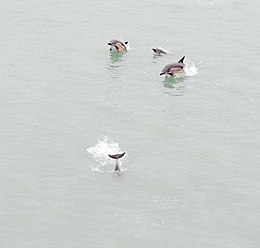
Common dolphins porpoising with a ferry at Batumi port
Ecological effects of pollution[edit]
Since the 1960s, rapid industrial expansion along the Black Sea coast line and the construction of a major dam has significantly increased annual variability in the N:P:Si ratio in the basin. In coastal areas, the biological effect of these changes has been an increase in the frequency of monospecific phytoplankton blooms, with diatom bloom frequency increasing by a factor of 2.5 and non-diatom bloom frequency increasing by a factor of 6. The non-diatoms, such as the prymnesiophytes Emiliania huxleyi (coccolithophore), Chromulina sp., and the Euglenophyte Eutreptia lanowii are able to out-compete diatom species because of the limited availability of Si, a necessary constituent of diatom frustules.[80] As a consequence of these blooms, benthic macrophyte populations were deprived of light, while anoxia caused mass mortality in marine animals.[81][82]
The decline in macrophytes was further compounded by overfishing during the 1970s, while the invasive ctenophore Mnemiopsis reduced the biomass of copepods and other zooplankton in the late 1980s. Additionally, an alien species—the warty comb jelly (Mnemiopsis leidyi)—was able to establish itself in the basin, exploding from a few individuals to estimated biomass of one billion metric tons.[83] The change in species composition in Black Sea waters also has consequences for hydrochemistry, as Ca-producing coccolithophores influence salinity and pH, although these ramifications have yet to be fully quantified. In central Black Sea waters, Si levels were also significantly reduced, due to a decrease in the flux of Si associated with advection across isopycnal surfaces. This phenomenon demonstrates the potential for localized alterations in Black Sea nutrient input to have basin-wide effects.
Pollution reduction and regulation efforts have led to a partial recovery of the Black Sea ecosystem during the 1990s, and an EU monitoring exercise, ‘EROS21’, revealed decreased N and P values, relative to the 1989 peak.[84] Recently, scientists have noted signs of ecological recovery, in part due to the construction of new sewage treatment plants in Slovakia, Hungary, Romania, and Bulgaria in connection with membership in the European Union. Mnemiopsis leidyi populations have been checked with the arrival of another alien species which feeds on them.[85]
-
Black Sea Common Dolphins with a kite-surfer off Sochi
Terrestrial[edit]

Statues of a man and a tiger, on the way to Mount Akhun.
In the past, the range of the Asiatic lion extended from South Asia to the Balkans, possibly up to the Danube. Places like Turkey and the Trans-Caucasus were in this range. The Caspian tiger occurred in eastern Turkey and the Caucasus, at least. The lyuti zver (Old East Slavic for “fierce animal”) that was encountered by Vladimir II Monomakh, Velikiy Kniaz of Kievan Rus’ (which ranged to the Black Sea in the south),[86] may have been a tiger or leopard, rather than a wolf or lynx, due to the way it behaved towards him and his horse.[87]
Climate[edit]
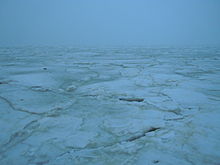
Ice on the Gulf of Odessa
Short-term climatic variation in the Black Sea region is significantly influenced by the operation of the North Atlantic oscillation, the climatic mechanisms resulting from the interaction between the north Atlantic and mid-latitude air masses.[88] While the exact mechanisms causing the North Atlantic Oscillation remain unclear,[89] it is thought the climate conditions established in western Europe mediate the heat and precipitation fluxes reaching Central Europe and Eurasia, regulating the formation of winter cyclones, which are largely responsible for regional precipitation inputs[90] and influence Mediterranean Sea Surface Temperatures (SST’s).[91]
The relative strength of these systems also limits the amount of cold air arriving from northern regions during winter.[92] Other influencing factors include the regional topography, as depressions and storms systems arriving from the Mediterranean are funneled through the low land around the Bosporus, Pontic and Caucasus mountain ranges acting as waveguides, limiting the speed and paths of cyclones passing through the region.[93]
Islands[edit]
|
This section does not cite any sources. (January 2018) (Learn how and when to remove this template message)
|
Some islands in the Black sea belong to Bulgaria, Romania, Turkey, and Ukraine:
- St. Thomas Island – Bulgaria
- St. Anastasia Island – Bulgaria
- St. Cyricus Island – Bulgaria
- St. Ivan Island – Bulgaria
- St. Peter Island – Bulgaria
- Sacalinu Mare Island – Romania
- Sacalinu Mic Island – Romania
- Misura / Novaya Zemliya – Romania and Ukraine
- Utrish Island
- Krupinin Island
- Sudiuk Island
- Kefken Island
- Oreke Island
- Giresun Island
- Dzharylgach Island – Ukraine
- Zmiinyi (Snake) Island – Ukraine
History[edit]
Mediterranean connection during the Holocene[edit]

The Bosporus, taken from the International Space Station

Map of the Dardanelles
The Black Sea is connected to the World Ocean by a chain of two shallow straits, the Dardanelles and the Bosporus. The Dardanelles is 55 m (180 ft) deep and the Bosporus is as shallow as 36 m (118 ft). By comparison, at the height of the last ice age, sea levels were more than 100 m (330 ft) lower than they are now.
There is also evidence that water levels in the Black Sea were considerably lower at some point during the post-glacial period. Some researchers theorize that the Black Sea had been a landlocked freshwater lake (at least in upper layers) during the last glaciation and for some time after.
In the aftermath of the last glacial period, water levels in the Black Sea and the Aegean Sea rose independently until they were high enough to exchange water. The exact timeline of this development is still subject to debate. One possibility is that the Black Sea filled first, with excess freshwater flowing over the Bosporus sill and eventually into the Mediterranean Sea. There are also catastrophic scenarios, such as the “Black Sea deluge theory” put forward by William Ryan, Walter Pitman and Petko Dimitrov.
Deluge hypothesis[edit]
The Black Sea deluge is a hypothesized catastrophic rise in the level of the Black Sea circa 5600 BC due to waters from the Mediterranean Sea breaching a sill in the Bosporus Strait. The hypothesis was headlined when The New York Times published it in December 1996, shortly before it was published in an academic journal.[94] While it is agreed that the sequence of events described did occur, there is debate over the suddenness, dating, and magnitude of the events. Relevant to the hypothesis is that its description has led some to connect this catastrophe with prehistoric flood myths.[95]
Recorded history[edit]
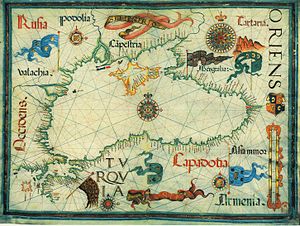
A medieval map of the Black Sea by Diogo Homem.
The Black Sea was a busy waterway on the crossroads of the ancient world: the Balkans to the west, the Eurasian steppes to the north, the Caucasus and Central Asia to the east, Asia Minor and Mesopotamia to the south, and Greece to the south-west.
The oldest processed gold in the world was found in Varna, Bulgaria, and Greek mythology portrays the Argonauts as sailing on the Black Sea. The land at the eastern end of the Black Sea, Colchis, (now Georgia), marked for the Greeks the edge of the known world.
The steppes to the north of the Black Sea have been suggested as the original homeland (Urheimat) of the speakers of the Proto-Indo-European language, (PIE) the progenitor of the Indo-European language family, by some scholars such as Marija Gimbutas; others move the homeland further east towards the Caspian Sea, yet others to Anatolia.
Greek presence in the Black Sea began at least as early as the 9th century BC with colonization of the Black Sea’s southern coast. By 500 BC, permanent Greek communities existed all around the Black Sea and a lucrative trade network connected the entirety of the Black Sea to the wider Mediterranean. While Greek colonies generally maintained very close cultural ties to their founding polis, Greek colonies in the Black Sea began to develop their own Black Sea Greek culture, know today as Pontic. The coastal community of Black Sea Greeks remained a prominent part of the Greek World for centuries.[96]
The Black Sea became a virtual Ottoman Navy lake within five years of Genoa losing the Crimean Peninsula in 1479, after which the only Western merchant vessels to sail its waters were those of Venice‘s old rival Ragusa. This restriction was challenged by the Russian Navy from 1783 until the relaxation of export controls in 1789 because of the French Revolution.[97][98]
The Black Sea was a significant naval theatre of World War I and saw both naval and land battles during World War II.
Archaeology[edit]

Ivan Aivazovsky. Black Sea Fleet in the Bay of Theodosia, just before the Crimean War
Ancient trade routes in the region are currently[when?] being extensively studied by scientists, as the Black Sea was sailed by Hittites, Carians, Colchians, Thracians, Greeks, Persians, Cimmerians, Scythians, Romans, Byzantines, Goths, Huns, Avars, Slavs, Varangians, Crusaders, Venetians, Genoese, Georgians, Tatars and Ottomans.
Perhaps the most promising areas in deepwater archaeology are the quest for submerged prehistoric settlements in the continental shelf and for ancient shipwrecks in the anoxic zone, which are expected to be exceptionally well preserved due to the absence of oxygen. This concentration of historical powers, combined with the preservative qualities of the deep anoxic waters of the Black Sea, has attracted increased interest from marine archaeologists who have begun to discover a large number of ancient ships and organic remains in a high state of preservation.
Modern use[edit]
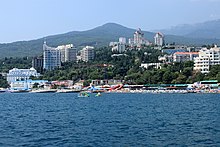
Yalta, Crimea
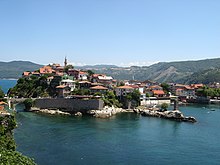
Amasra, Turkey, is located on a small island in the Black Sea
Commercial and civic use[edit]
According to NATO, the Black sea is a strategic corridor that provides smuggling channels for moving legal and illegal goods including drugs, radioactive materials, and counterfeit goods that can be used to finance terrorism.[99]
[edit]
Ports and ferry terminals[edit]
According to the International Transport Workers’ Federation 2013 study, there were at least 30 operating merchant seaports in the Black Sea (including at least 12 in Ukraine).[100]
Merchant fleet and traffic[edit]
According to the International Transport Workers’ Federation 2013 study, there were around 2,400 commercial vessels operating in the Black Sea.[100]
Fishing[edit]
Anchovy: the Turkish commercial fishing fleet catches around 300,000 tons per year on average, and fishery carried out mainly in winter and the highest portion of the stock is caught between November and December.[101]
Hydrocarbons exploration[edit]
Since the 1980s, the Soviet Union started offshore drilling for petroleum in the sea’s western portion (adjoining Ukraine‘s coast). Independent Ukraine continued and intensified that effort within its exclusive economic zone, inviting major international oil companies for exploration. Discovery of the new, massive oilfields in the area stimulated an influx of foreign investments. It also provoked a short-term peaceful territorial dispute with Romania which was resolved in 2011 by an international court redefining the exclusive economic zones between the two countries.
Holiday resorts and spas[edit]
In the years following the end of the Cold War, the popularity of the Black Sea as a tourist destination steadily increased. Tourism at Black Sea resorts became one of the region’s growth industries.[102] The following is a list of notable Black Sea resort towns:
- 2 Mai (Romania)
- Agigea (Romania)
- Ahtopol (Bulgaria)
- Amasra (Turkey)
- Anaklia (Georgia)
- Anapa (Russia)
- Albena (Bulgaria)
- Alupka (Crimea, Ukraine/Russia (disputed))
- Alushta (Crimea, Ukraine/Russia (disputed))
- Balchik (Bulgaria)
- Batumi (Georgia)[103]
- Burgas (Bulgaria)
- Byala (Bulgaria)
- Cap Aurora (Romania)
- Chakvi (Georgia)
- Constantine and Helena (Bulgaria)
- Constanța (Romania)
- Corbu (Romania)
- Costineşti (Romania)
- Eforie (Romania)
- Emona (Bulgaria)
- Eupatoria (Crimea, Ukraine/Russia (disputed))
- Foros (Crimea, Ukraine/Russia (disputed))
- Feodosiya (Crimea, Ukraine/Russia (disputed))
- Giresun (Turkey)
- Gagra (Abkhazia, Georgia[a])
- Gelendzhik (Russia)
- Golden Sands (Bulgaria)
- Gonio (Georgia)
- Gurzuf (Crimea, Ukraine/Russia (disputed))
- Hopa (Artvin, Turkey)
- Istanbul (Turkey)
- Jupiter (Romania)
- Kamchia (Bulgaria)
- Kavarna (Bulgaria)
- Kiten (Bulgaria)
- Kobuleti (Georgia)
- Koktebel (Crimea, Ukraine/Russia (disputed))
- Lozenetz (Bulgaria)
- Mamaia (Romania)
- Mangalia (Romania)
- Năvodari (Romania)
- Neptun (Romania)
- Nesebar (Bulgaria)
- Novorossiysk (Russia)
- Ordu (Turkey)
- Obzor (Bulgaria)
- Odessa (Ukraine)
- Olimp (Romania)
- Pitsunda (Abkhazia, Georgia[a])
- Pomorie (Bulgaria)
- Primorsko (Bulgaria)
- Rize (Turkey)
- Rusalka (Bulgaria)
- Samsun (Turkey)
- Saturn (Romania)
- Sinop (Turkey)
- Sochi (Russia)
- Sozopol (Bulgaria)
- Sudak (Crimea, Ukraine/Russia (disputed))
- Skadovsk (Ukraine)
- Sulina (Romania)
- Sunny Beach (Bulgaria)
- Şile (Turkey)
- Sveti Vlas (Bulgaria)
- Trabzon (Turkey)
- Tsikhisdziri (Georgia)
- Tuapse (Russia)
- Ureki (Georgia)
- Vama Veche (Romania)
- Varna (Bulgaria)
- Venus (Romania)
- Yalta (Crimea, Ukraine/Russia (disputed))
- Zonguldak (Turkey)

Soviet frigate Bezzavetny (right) bumping the USS Yorktown during the 1988 Black Sea bumping incident.

Ukrainian Navy artillery boat U170 in the Bay of Sevastopol
Modern military use[edit]
International and military use of the Straits[edit]
The 1936 Montreux Convention provides for free passage of civilian ships between the international waters of the Black and the Mediterranean Seas. However, a single country (Turkey) has complete control over the straits connecting the two seas. Military ships are separate categories from civilian ships and they can only pass through the straits if the ship is belonging to a Black Seapower. Other military ships have the right to pass through the straits if they are not in a war against Turkey and they can stay in the Black Sea basin for a limited time. The 1982 amendments to the Montreux Convention allow Turkey to close the Straits at its discretion in both wartime and peacetime.[104]
The 1936 Montreux Convention governs the passage of vessels between the Black, the Mediterranean and Aegean Seas and the presence of military vessels belonging to non-littoral states in the Black Sea waters.[105]
In December 2018, the Kerch Strait incident took place. The Russian Navy and Coast guard took control of three ships belonging to their counterparts. The ships were trying to enter the Black Sea[106]






